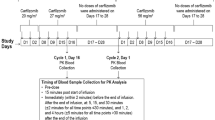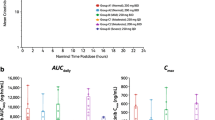Abstract
Etoposide dosage in patients with liver dysfunction remains controversial. Since etoposide has a hepatic component to its clearance (CL) and shows a high degree of protein binding, hepatic impairment could affect etoposide disposition. However, the empiric recommendation that the dose of etoposide be decreased in such patients may reduce systemic exposure and be detrimental to its antitumor activity. To address these issues we studied the pharmacokinetics (PK) of etoposide in patients with hepatocellular carcinoma (HCC) and underlying cirrhosis (n= 17) treated with daily oral etoposide. Unbound etoposide was obtained by ultrafiltration. Etoposide concentrations (total and free drug) were measured by high-performance liquid chromatography (HPLC) and analyzed by noncompartmental equations. The patients had mild or moderate liver dysfunction. Albuminemia was in the normal range for all the patients. Creatininemia was normal in all but two patients. PK results (mean and range) showed that etoposide disposition was unchanged in patients with liver dysfunction. We found slightly high etoposide bioavailability [F, 61% (17–95%)] and clearance [CL, 1.1 (0.7–2.3) l h−1 m−2] resulting in a normal degree of systemic exposure (AUCoral 27 μg h ml−1). Normal protein binding [PB 93.2% (84.4–98.1%)] contributed to a normal level of exposure to free drug (AUCf, oral 1.9 μg h ml−1). The distribution volume [VSS 8.4 (6.1–13.2) l/m2] and the effective half-life [t 1/2eff, 5.1 (3.0–9.6) h] were normal. Median CL and protein binding did not differ in the seven patients with total bilirubin value of >1.2 mg/dl as compared with the ten patients with total bilirubin levels of ≤1.2 mg/dl (1.3 versus 1.0 l h−1 m−2 and 92.5% versus 93.4%, respectively). In agreement with this PK finding, we observed no clinical evidence of increased toxicity in patients with hyperbilirubinemia as compared with patients with normal bilirubinemia (mean WBC decrease 38% versus 47%). The only case of severe (grade 4) hematological toxicity was observed in one patient with reduced glomerular filtration. Since the pharmacological effects of etoposide correlate with the level of systemic exposure to the free drug, our data suggest that no dose reduction is needed in patients with HCC. It is even possible to increase the dose intensity in patients with favorable PK parameters under appropriate hematological and therapeutic drug monitoring.
Similar content being viewed by others
Author information
Authors and Affiliations
Additional information
Received: 11 May 1998 / Accepted: 5 August 1998
Rights and permissions
About this article
Cite this article
Aita, P., Robieux, I., Sorio, R. et al. Pharmacokinetics of oral etoposide in patients with hepatocellular carcinoma. Cancer Chemother Pharmacol 43, 287–294 (1999). https://doi.org/10.1007/s002800050897
Issue Date:
DOI: https://doi.org/10.1007/s002800050897




